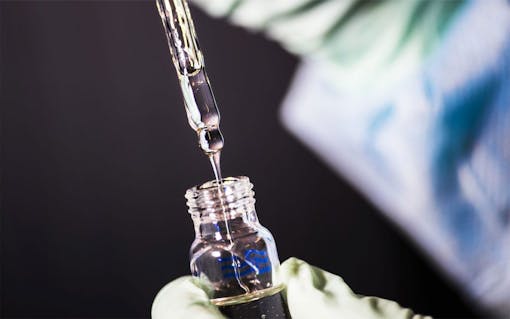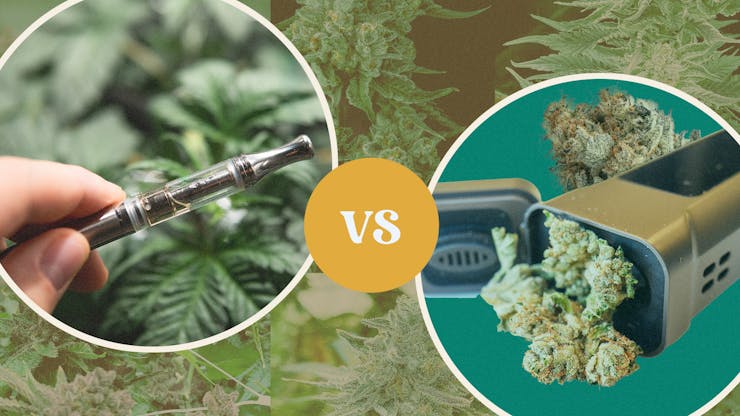Mind & Matter is a monthly column by neuroscientist & plant chemistry researcher Nick Jikomes, PhD. You can find more of his science content here.
Physics & chemistry of vaping vs. smoking

Vaping and smoking both involve applying high temperatures to a material in order to cause it to transform from a solid or liquid into an aerosol, allowing it to be inhaled. The difference between vaping and smoking lies in how high the temperature is. At relatively low temperatures, molecules simply vaporize–changing from solid or liquid into an aerosol. If things are hot enough, combustion occurs. This causes the same molecules to not only vaporize but convert into other things (e.g. THCA → THC). It can also cause them to degrade into potentially harmful byproducts. When you smoke something by applying a flame or very hot heating element to marijuana, you’re inhaling a mixture of what you want (vaporized cannabinoids, terpenes, etc.) together with degradation byproducts.
The vaporization temperature needed to make something inhalable depends on the specific molecule you’re talking about as well as the physical substrate it’s in. For example, the vaporization temperature for THC is different for dried flower compared to concentrated oil, and will also vary somewhat between different types of concentrates. In general, the temperature needed to vaporize THC and other cannabinoids in flower is lower, roughly 200 Celsius (392 Fahrenheit). Many vaporization devices for concentrates use temperatures ranging from ~220 Celsius at the low end up to 400 Celsius or higher (752 Fahrenheit). Concentrates are also often consumed using very hot heating elements, which involve combustion of the product.
Vaping vs. smoking: How do they influence the experience?

Let’s say you vaporize a cannabis concentrate at a relatively low temperature (<300 C). Will the experience be different than if you smoke the same amount of the same product, using very high temperatures where combustion is occurring?
Yes.
For one thing, the smoke arising from the combusted material will likely contain particles of a different size than vapor, affecting their ability to be absorbed in the lungs. In addition, much of the smoke (and therefore THC), will be lost to the environment. Every time someone coughs out or exhales a big cloud of smoke, they’re losing THC. All other things being equal, the smoke will contain less THC, simply because some of it will degrade into other things (which you will also inhale). In a 2018 study looking at the effects of smoked vs. vaporized marijuana flower, vaporization tended to produce higher levels of intoxication compared to smoking when the same amount of material was held constant. This was interpreted to mean that vaporizers are a more efficient way to deliver THC to the body than traditional smoked preparations.
Learn more about cannabis science directly from the experts.
Consumers commonly report that the high from vaporized vs. smoked cannabis feels different, often preferring the subjective effects from smoking. Assuming this is true even when consuming the exact same amount of THC, what could explain it? One answer could be that marijuana smoke can contain many other things not found in vapor. One key difference between marijuana smoke and vapor is that smoke typically has higher levels of carbon monoxide, which “outcompetes” oxygen for access to red blood cells. This leads to mild hypoxia: less oxygen is delivered to the body’s tissues. In my recent conversation with Dr. Echo Rufer, a toxicologist at PAX, she hypothesized that the mild hypoxia associated with smoking may contribute to different subjective effects compared to vaporized cannabis, which some consumers might prefer. Further testing will be required to determine whether this hypothesis is correct.
However, higher temperatures are more likely to generate more harmful thermal degradation byproducts.
Flavor will also differ for vaping compared to smoking, and for vaping at one temperature vs. another. For cannabis, a lot of flavor comes from terpenes, small aromatic compounds found in many products. Terpenes vaporize at lower temperatures than cannabinoids. For this reason, the ratio of terpenes to cannabinoids will change across a range of vaporization temperatures. Lower temperatures will tend to have a higher terpene-to-cannabinoid ratio and more “terp flavor.” Whether this is desirable or not depends on your own taste. However, higher temperatures are more likely to generate harmful thermal degradation byproducts. If you’re using a temperature-adjustable vaporization device, it’s worth trying a range of temperatures to see how this influences the flavor and “smoothness” of the vapor.
Health risks of vaping vs. smoking
Assuming your marijuana product does not contain harmful additives and your device is properly designed (see below), vaporization will produce far fewer potentially harmful byproducts compared to combustion (smoking). The lower the temperature, the less likely it is that you’re inhaling things beyond what your starting material contains. Smoke is definitely more harmful than vapor in terms of the volume and diversity of potentially harmful compounds you inhale.
The composition of tobacco smoke has been intensively studied and over 90 harmful and potentially harmful constituents have been identified. This includes things like carcinogens, which is why tobacco smoking carries an increased cancer risk. Although nicotine is the psychoactive and main addictive component of tobacco smoke, it is actually the harmful byproducts of burned plant material that are responsible for tobacco smoke’s carcinogenicity.
There are also purely physical considerations of vapor vs. smoke with respect to lung health. Smoke is hotter and denser than vapor, which means that it will be more irritating and physically damaging to the lungs (again, assuming your vaporized product doesn’t contain any additional harmful additives).
Shop highly rated dispensaries near you
Showing you dispensaries nearImportant caveats aside, vaporization will almost always carry fewer health risks than smoking.
Additives & diluents

Compared to nicotine products, cannabis oil has a very useful property: it can be inhaled as-is, not requiring the use of diluents or synthetic flavor additives. Most nicotine vape products contain ~1-5% nicotine. The majority of the product consists of a diluent used to dilute the nicotine down to these levels. Nicotine vapor can become highly irritating and produce undesirable effects if the nicotine concentration is too high, which is why diluents are used. No one would want to vape a nicotine product with 90%, 50%, or even 20% nicotine.
Cannabis concentrates are often very high in THC, with concentrations routinely above 75% and often even 95-99% THC (e.g., distillate). Cannabis oil simply doesn’t need to be diluted in the same way nicotine does to avoid intense physical irritation and side effects, or to achieve the desired psychoactive effects. Sometimes diluents are used in cannabis oil, but this is typically done to maintain consistent THC levels across product batches. These cannabis diluents are used in much smaller concentrations than nicotine vape products, typically consisting of things like botanical terpenes, which are native to raw cannabis oil.
Occasionally you may see cannabis oils containing other diluents, such as PG/VG (commonly used in nicotine vape products). However, cannabinoids vaporize at higher temperatures than nicotine, so it’s possible that vaping cannabis oil containing these diluents will produce vapor with potentially harmful byproducts.
It’s important to emphasize that illicit cannabis vape products should be avoided altogether. These can contain diluents or additives that may be very harmful, or even deadly. The EVALI public health crisis from a few years back involved illicit market cannabis vape products containing vitamin E acetate, leading to a number of deaths (see my conversation with toxicologist Dr. Echo Rufer for more detail).
Hardware considerations for vaping

There are also hardware considerations for vaporizing cannabis. One key design feature is the airpath of the cannabis vapor, which should never pass over the internal electronic components of the device. These electronic components can contain heavy metals or residual solvents used in the manufacturing process. Your cannabis vapor can pick up these nasty things if it comes in contact with the internal components of the device. Fortunately, most reusable cannabis vaporization devices from well-established brands are designed to prevent the air path from passing over internal device components. However, you will need to look at the design specifications to be sure. It is apparently more common to see disposable vaporization devices where the air path comes in contact with internal components.
To learn more about vaporization, smoking, and the topics discussed in this article, check out my conversation with Dr. Echo Rufer:





